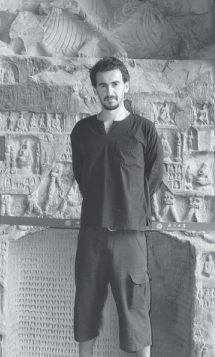Man of letters finds words of inspiration

For Pietro de Laurentis, an Italian Sinologist who has been dedicated to Chinese studies for two decades, what fascinated him most about Hangzhou, capital of East China's Zhejiang province, was not the scenic West Lake or the delicious cuisine, but rather, Chinese calligraphy.
Anyone who has studied Mandarin knows that Chinese characters play a dominant role in the language. Chinese characters have their own meaning and history.
"Hangzhou is unique, because it gave me enlightenment on Chinese calligraphy," says de Laurentis.
De Laurentis is a researcher with years of experience in studying modern Chinese, ancient Chinese and Chinese calligraphy in China. His first visit to the country was back in 1998 and since then, he says, he has visited the country numerous times.
Majoring in Chinese, de Laurentis' interest in Chinese calligraphy sprouted at an Italian university in 1999, which helped him make some Chinese friends from Shanghai residing in Italy, including a calligraphy teacher.
In an article of recollection, de Laurentis points out that he believed that culture is not just knowledge he learned in textbooks. "When I was studying Chinese at the university, I found there's an oasis of culture ahead of me," he writes.
"The Chinese culture in textbooks is charming, but I am more interested in Chinese people," he notes, adding that Chinese characters and calligraphy are what he uses to communicate with people from China.
Having learned about de Laurentis' passion about Chinese calligraphy, his Chinese friends suggested that he should go to Hangzhou, a city of calligraphy and home of the China Academy of Art to further study the time-honored calligraphy in an authentic atmosphere.
In 2000, de Laurentis became an international student at the academy, where he says he learned the "essentials of using a brush pen to write" during a one-year calligraphy course.
However, the course at the academy didn't give the Italian enough knowledge about the sources of Chinese calligraphy. "I was interested in the academic study of Chinese calligraphy, but the course I took was in another direction," he says.
De Laurentis became a doctoral candidate back in Italy in 2003 with the aim of going further into researching Chinese calligraphy.
"Besides a Sinologist who studies Chinese calligraphy, I wanted to be an excellent calligrapher," he says. "Only in China can an international student become a really good calligrapher."
He went to Hangzhou again in 2004 and took a graduate course at Zhejiang University. "It was at Zhejiang University that I got really immersed in academic studies and learned to view academic issues from historical and cultural perspectives," the Sinologist says.
During the time at Zhejiang University, de Laurentis decided to delve into Treatise on Calligraphy by Sun Guoting, a Chinese calligrapher of the early Tang Dynasty (618-907), for his doctoral dissertation.
"I was profoundly impressed by the grandeur and elegance of the long scroll replica, which is 9.06 meters long," he says.
With the help of abundant resources at the university and his Chinese classmates, the research went well and later became the core of de Laurentis' doctoral dissertation.
He didn't finish his graduate course at Zhejiang University. Instead, he went back to Italy for the doctoral study in 2005 and now he is a lecturer at an Italian university and still keeps contact with his Chinese peers.
He explained that as a Sinologist from the West, he should have an international perspective. "Staying in China for too much time might not be the best choice," says de Laurentis.
He has attended many academic activities in China in the past 15 years since he decided to go back to his motherland, including giving public lectures at Chinese universities and taking part in researches as a visiting scholar.
"I cherish the experience of communicating with the public, which proves that rather than a highbrow art, calligraphy can be enjoyed by all people."
In 2018, de Laurentis wrote a dozen articles based on his 20-year learning experience in China. One year later, he was invited to write and compile a book about the renowned Chinese calligrapher Wang Xizhi, which is expected to be published later this year.


Today's Top News
- Monetary policy likely to stay accommodative in H2
- World Heritage sites bear new fruit
- Xi stresses key role of public opinion
- Beijing plugs safety gaps amid rain alert
- War-themed movies teach important lessons
- Xi urges studying, absorbing netizens' opinions in formulating 15th Five-Year Plan































